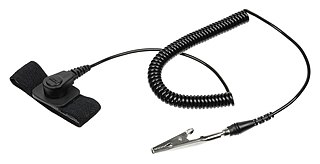
Electromagnetic compatibility (EMC) is the ability of electrical equipment and systems to function acceptably in their electromagnetic environment, by limiting the unintentional generation, propagation and reception of electromagnetic energy which may cause unwanted effects such as electromagnetic interference (EMI) or even physical damage in operational equipment. The goal of EMC is the correct operation of different equipment in a common electromagnetic environment. It is also the name given to the associated branch of electrical engineering.
Conformance testing — an element of conformity assessment, and also known as compliance testing, or type testing — is testing or other activities that determine whether a process, product, or service complies with the requirements of a specification, technical standard, contract, or regulation. Testing is often either logical testing or physical testing. The test procedures may involve other criteria from mathematical testing or chemical testing. Beyond simple conformance, other requirements for efficiency, interoperability or compliance may apply. Conformance testing may be undertaken by the producer of the product or service being assessed, by a user, or by an accredited independent organization, which can sometimes be the author of the standard being used. When testing is accompanied by certification, the products or services may then be advertised as being certified in compliance with the referred technical standard. Manufacturers and suppliers of products and services rely on such certification including listing on the certification body's website, to assure quality to the end user and that competing suppliers are on the same level.

The triboelectric effect is a type of contact electrification on which certain materials become electrically charged after they are separated from a different material with which they were in contact. Rubbing the two materials with each other increases the contact between their surfaces, and hence the triboelectric effect. Rubbing glass with fur for example, or a plastic comb through the hair, can build up triboelectricity. Most everyday static electricity is triboelectric. The polarity and strength of the charges produced differ according to the materials, surface roughness, temperature, strain, and other properties.

Electrostatic discharge (ESD) is a sudden and momentary flow of electric current between two electrically charged objects caused by contact, an electrical short or dielectric breakdown. A buildup of static electricity can be caused by tribocharging or by electrostatic induction. The ESD occurs when differently-charged objects are brought close together or when the dielectric between them breaks down, often creating a visible spark.
The JEDEC Solid State Technology Association is an independent semiconductor engineering trade organization and standardization body headquartered in Arlington County, Virginia, United States.
CDM may refer to:

Static electricity is an imbalance of electric charges within or on the surface of a material or between materials. The charge remains until it is able to move away by means of an electric current or electrical discharge. Static electricity is named in contrast with current electricity, where the electric charge flows through an electrical conductor or space, and transmits energy.

High voltage electricity refers to electrical potential large enough to cause injury or damage. In certain industries, high voltage refers to voltage above a certain threshold. Equipment and conductors that carry high voltage warrant special safety requirements and procedures.

An electrostatic precipitator (ESP) is a filterless device that removes fine particles, such as dust and smoke, from a flowing gas using the force of an induced electrostatic charge minimally impeding the flow of gases through the unit.
Double Data Rate 3 Synchronous Dynamic Random-Access Memory is a type of synchronous dynamic random-access memory (SDRAM) with a high bandwidth interface, and has been in use since 2007. It is the higher-speed successor to DDR and DDR2 and predecessor to DDR4 synchronous dynamic random-access memory (SDRAM) chips. DDR3 SDRAM is neither forward nor backward compatible with any earlier type of random-access memory (RAM) because of different signaling voltages, timings, and other factors.

Stax Ltd. is a Japanese company that makes high-end-audio equipment. Stax is best known for their electrostatic and electret headphones, which they call “earspeakers.” Electrostatic headphones work similarly to electrostatic loudspeakers, but on a smaller scale. In December 2011, Chinese audio equipment company Edifier announced that it had acquired 100% equity in Stax.
An electrostatic detection device, or EDD, is a specialized piece of equipment commonly used in questioned document examination to reveal indentations or impressions in paper that may otherwise go unnoticed. It is a non-destructive technique, allowing further tests to be carried out. It is a sensitive technique capable of detecting indentations on pages several layers below the top sheet and many years after the indentations were created.
Body capacitance is the physical property of the human body that has it act as a capacitor. Like any other electrically-conductive object, a human body can store electric charge if insulated. The actual amount of capacitance varies with the surroundings; it would be low when standing on top of a pole with nothing nearby, but high when leaning against an insulated, but grounded large metal surface, such as a household refrigerator, or a metal wall in a factory.

The human-body model (HBM) is the most commonly used model for characterizing the susceptibility of an electronic device to damage from electrostatic discharge (ESD). The model is a simulation of the discharge which might occur when a human touches an electronic device.

In electronics, TO-3 is a designation for a standardized metal semiconductor package used for power semiconductors, including transistors, silicon controlled rectifiers, and, integrated circuits. TO stands for "Transistor Outline" and relates to a series of technical drawings produced by JEDEC.

An antistatic device is any device that reduces, dampens, or otherwise inhibits electrostatic discharge, or ESD, which is the buildup or discharge of static electricity. ESD can damage electrical components such as computer hard drives, and even ignite flammable liquids and gases.
Transmission-Line Pulse (TLP) is a way to study integrated circuit technologies and circuit behavior in the current and time domain of electrostatic-discharge (ESD) events. The concept was described shortly after WWII in pp. 175–189 of Pulse Generators, Vol. 5 of the MIT Radiation Lab Series. Also, D. Bradley, J. Higgins, M. Key, and S. Majumdar realized a TLP-based laser-triggered spark gap for kilovolt pulses of accurately variable timing in 1969. For investigation of ESD and electrical-overstress (EOS) effects a measurement system using a TLP generator has been introduced first by T. Maloney and N. Khurana in 1985. Since then, the technique has become indispensable for integrated circuit ESD protection development.
Low voltage complementary metal oxide semiconductor (LVCMOS) is a low voltage class of CMOS technology digital integrated circuits.

An ESD simulator, also known as an ESD gun, is a handheld unit used to test the immunity of devices to electrostatic discharge (ESD). These simulators are used in special electromagnetic compatibility (EMC) laboratories. ESD pulses are fast, high-voltage pulses created when two objects with different electrical charges come into close proximity or contact. Recreating them in a test environment helps to verify that the device under test is immune to static electricity discharges.
A USB Killer is a device that is designed to be portable and sends high-voltage power surges repeatedly into the data lines of the device it is connected to, which will damage hardware components on unprotected devices. The device has been designed to test components for protection from power surges and electrostatic discharge.